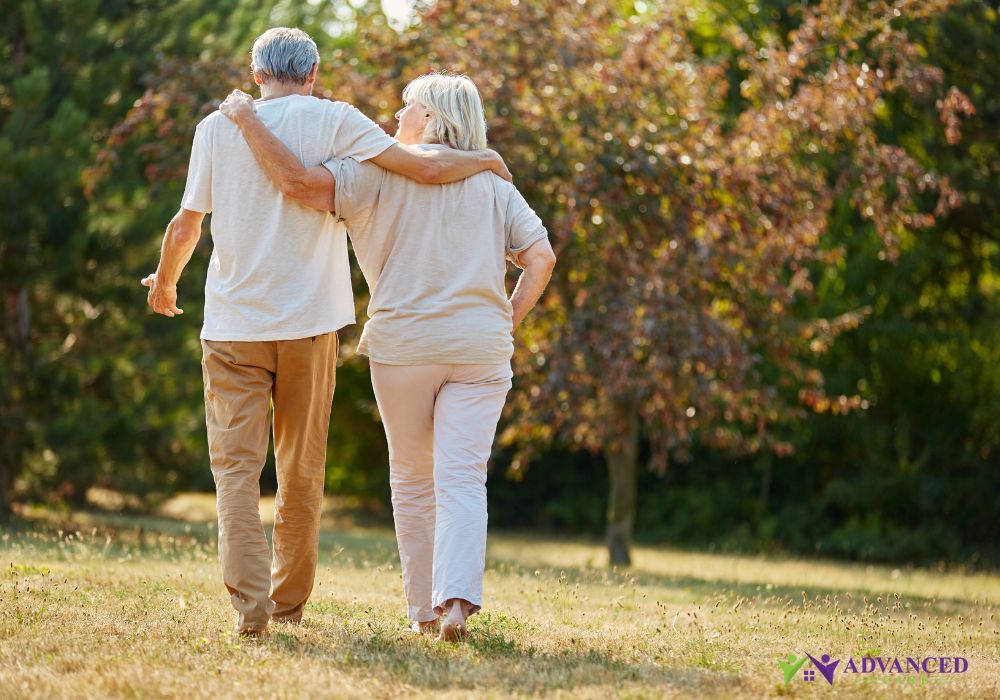Spending time outdoors offers numerous physical and emotional benefits for seniors, from fresh air and natural sunlight to opportunities for gentle exercise and relaxation. However, as individuals age, mobility challenges and other health concerns may make outdoor activities more difficult. At Advanced Care, we believe that everyone, regardless of age, should be able to enjoy the outdoors safely and comfortably. In this blog, we’ll explore how to create safe and accessible outdoor spaces for seniors, ensuring that they can take full advantage of their surroundings without the risk of injury.
The Importance of Outdoor Time for Seniors
Boosting Mental and Emotional Well-Being
Outdoor spaces provide seniors with the opportunity to connect with nature, which can significantly enhance mental health. Spending time in green spaces has been shown to reduce stress, lower levels of anxiety, and improve mood. Whether it’s sitting on a sunny patio, tending to a small garden, or taking a walk around the yard, the outdoors can provide a calming and refreshing experience for seniors, reducing feelings of isolation and loneliness.
Encouraging Physical Activity
Physical activity is essential for maintaining mobility and overall health, particularly for seniors. Even low-impact activities such as walking on a smooth, flat surface, practicing gentle stretches, or engaging in gardening can promote flexibility, strength, and cardiovascular health. Well-designed outdoor spaces can encourage seniors to stay active and engage in activities that keep their bodies moving, without overexertion or the risk of falling.
Designing Accessible Outdoor Spaces
Smooth, Even Pathways
One of the most important aspects of an outdoor space for seniors is the creation of safe and accessible pathways. Uneven surfaces, gravel, and cracks can be hazardous for those with mobility issues or who use assistive devices such as walkers or canes. Paved pathways with slip-resistant materials should be installed to ensure that seniors can move freely and confidently. These paths should also be wide enough to accommodate wheelchairs or walkers, allowing for easy navigation.
Adequate Lighting
Proper lighting is essential for preventing accidents and ensuring safety in outdoor areas. Seniors may struggle with vision issues, making it harder for them to see obstacles or uneven terrain. Motion-sensor lighting can be helpful for illuminating pathways and entrances without the need for manual switches. Ensuring that all outdoor areas are well-lit during evening hours can prevent falls and help seniors feel secure when moving around outside after dark.
Level Changes and Stairs
If the outdoor space includes stairs or level changes, installing sturdy handrails is essential for providing stability and support. Ramps should be added where possible to reduce the need for climbing stairs altogether, making the space more accessible for seniors who use wheelchairs or have difficulty with steps. Non-slip materials should be used on ramps and stairs to reduce the risk of slipping, especially in wet weather.
Enhancing Outdoor Comfort
Shaded Areas for Protection from Sun
Seniors are more susceptible to heat-related illnesses such as heat exhaustion and dehydration. Providing shaded areas, such as covered patios, gazebos, or large umbrellas, can help protect them from excessive sun exposure while still allowing them to enjoy the outdoors. These shaded areas should be easily accessible and equipped with comfortable seating where seniors can rest and relax.
Comfortable Seating
Outdoor seating should be comfortable, stable, and easy to get in and out of. Lightweight or flimsy chairs may not provide the necessary support for seniors with mobility issues. Choose sturdy, ergonomic seating options with armrests to help seniors stand up more easily. Benches with cushions or padded chairs can make sitting outside more enjoyable, encouraging seniors to spend more time outdoors.
Wind Protection
While outdoor spaces can be refreshing, windy days may deter seniors from spending time outside. Adding windbreakers, such as screens, fences, or hedges, can create a more sheltered environment, making the outdoor area more pleasant. These additions also provide privacy and create a cozy atmosphere for relaxation.
Making Outdoor Spaces Safe
Eliminating Trip Hazards
Trip hazards are a significant concern in any outdoor area for seniors. Make sure to clear away any obstacles such as loose garden hoses, fallen branches, or gardening tools that may cause someone to trip. Additionally, ensure that the grass is mowed regularly, as long grass can hide uneven ground or other potential hazards.
Non-Slip Surfaces
Wet surfaces, especially after rain, can become extremely slippery and pose a danger to seniors. Using non-slip materials for walkways and patios is essential in reducing the risk of falls. Rubber or textured concrete are excellent choices for outdoor flooring, as they provide traction even when wet. Additionally, placing non-slip mats near entrance doors can help prevent accidents when transitioning from indoor to outdoor spaces.
Proper Garden Maintenance
If your outdoor space includes a garden, regular maintenance is crucial for keeping the area safe for seniors. Overgrown plants or branches can obstruct walkways, making it difficult to navigate. Ensure that hedges, bushes, and flower beds are kept well-trimmed, and remove any debris from the ground. Raised garden beds can also make gardening more accessible for seniors by reducing the need to bend down, allowing them to continue enjoying their favorite outdoor activities.
Encouraging Social Interaction and Enjoyment
Creating Gathering Spaces
Outdoor areas can also serve as spaces for social interaction. Setting up a comfortable seating area with a table allows seniors to enjoy meals, tea, or conversations with family and friends. These spaces can encourage socialization, helping to reduce feelings of isolation and provide opportunities for seniors to engage with their loved ones.
Accessible Gardening
Gardening is a therapeutic and enjoyable activity for many seniors, but it can become challenging as mobility decreases. To ensure that gardening remains accessible, raised garden beds or container gardens can be installed to reduce the need for bending and kneeling. These modifications allow seniors to continue tending to their plants and flowers without straining their backs or joints.
Incorporating Nature and Wildlife
Adding natural elements like bird feeders, flower beds, or small water features can enhance the outdoor experience for seniors. Watching birds or butterflies can be a peaceful and stimulating activity, providing a sense of connection to the natural world. These small touches can bring added enjoyment to the space while making the environment more engaging and lively.
Final Thoughts
Creating a safe and enjoyable outdoor space for seniors is not only about ensuring their physical safety but also about enhancing their overall well-being. By designing outdoor areas that are accessible, comfortable, and free from hazards, seniors can continue to enjoy the benefits of nature without worry. At Advanced Care, we are committed to helping seniors maintain their independence and quality of life. Whether through in-home assistance or helping families create safe environments, we strive to support seniors in every aspect of their lives. If you’re looking for more guidance on creating accessible outdoor spaces for your loved one, contact us today to learn more about our services and how we can help.






